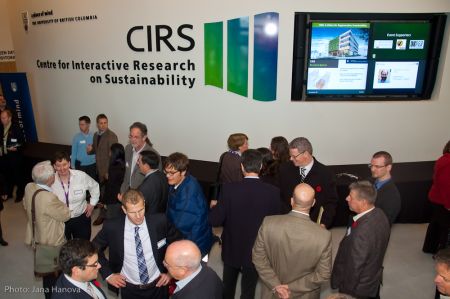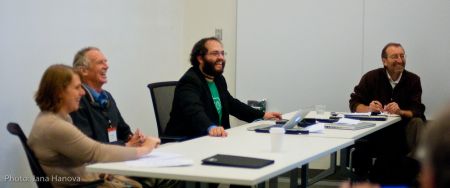Next, Katy Appleton from the University of East Anglia gave an overview of evaluation research with regard to climate change visualizations ("Evaluating the Use of Visualization for Communication about Climate Change"). She asked what works best and how far visualizations can improve understanding, engagement, support for policies, and individual change of behavior. Considering the technical development and the lack of evaluation research described by Lange (2011) in "99 volumes later. We can visualize. Now what?" it became clear that we need an updated research agenda on the evaluation of landscape visualization.
Finally, Joe Salomon from 350.org provided a visually strong link to activism and shared his stories how 350.org got millions of people in every country around the world except North Korea involved in climate action. Social media such as twitter did play an important role and perhaps educational games will do as well but in the end, "real life is the most exiting game".
The following panel discussion addressed questions how to integrate visualizations and social media in the best way, how to engage people, and how to evaluate such projects.
The afternoon panel was started by Arnim Wiek (Arizona State University) who addressed the question of "Effective Stakeholder Engagement in Transformative Sustainability Efforts" with a case study from Phoenix with the emphasis on transformation. There are some good scenario studies but how do we get from scenarios to actual implementation, i.e. truly transformative outcomes? Arnim Wiek finished with six recommendations how to support transformative action, i.e. 1) go beyond scenarios, 2) go beyond the usual suspects, 3) train and coach facilitators, 4) move from extraction to negotiation, 5) embrace community diversity, 6) mobilize the Decision Theatre at CIRS. For the later, he also recommended increased collaboration and a shared research agenda.
Second speaker at the afternoon panel was Michael Flaxman (MIT), who presented a project on "Climate Change Adaptation in Southern Florida's Everglades Landscape: A Spatial Resilience Planning Approach". In this project, a scenario-based participatory stakeholder process with about 200 professional community members was implemented. The goal was to simulate alternative futures considering climate change; effects on wildlife habitats and species; and provide a sensitivity analysis of policies. The three drivers for the scenario development were 1) rapid population growth, 2) planning assumptions regarding land use and water and 3) climate change. The planning process was very well structured and accompanied by an evaluation, allowing to draw most valuable insights. Visualizations, especially in the form of maps, were another integral part of the process and Michael Flaxman particularly suggested interactive web maps as a very promising tool for regional planning.


